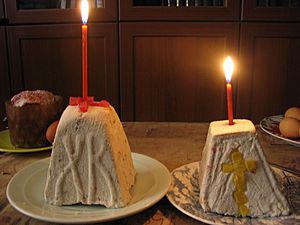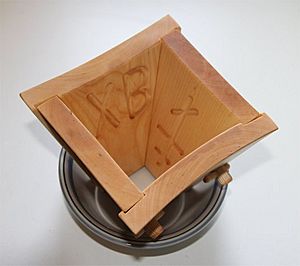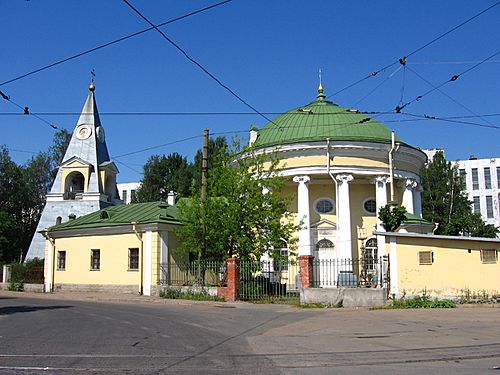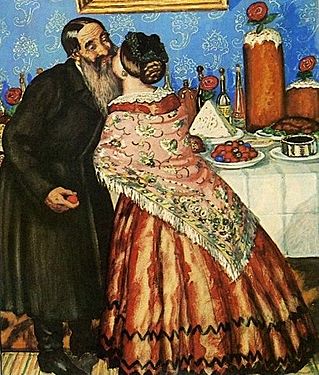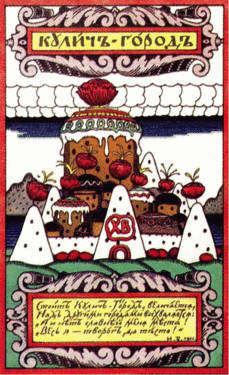Paskha facts for kids
Paskha (pronounced PAHS-kha) is a special and delicious dish made in countries where people follow the Eastern Orthodox Christian faith. It's a traditional treat for Easter, which is called Pascha in these countries. Paskha is made from foods that people give up during the Great Fast, a time before Easter. It's prepared during Holy Week and then taken to church on Holy Saturday to be blessed. You can find Paskha in places like Russia, Ukraine, and even Finland.
Contents
What is Paskha?
Paskha is a traditional Easter dish made mainly from a type of soft cheese called quark (or tvorog in Russian). This cheese is white, which reminds people of the purity of Jesus and the joy of his Resurrection.
Paskha is usually shaped like a pyramid. This shape can symbolize a few things:
- The first Passover in Egypt, connecting to the early Jewish roots of Christianity.
- The Trinity (God the Father, God the Son, and the Holy Spirit).
- The Church itself.
- The Tomb of Christ.
Paskha is often served with other rich Easter breads, like paska in Ukraine or kulich in Russia. These foods are full of dairy ingredients that people avoid during the Great Fast. They are all brought to church on Easter to be blessed by a priest.
How Paskha is Decorated
Paskha is often decorated with special religious symbols. You might see the Orthodox three-bar cross on it. Also, the letters X and B are common. These are Cyrillic letters that stand for Христосъ Воскресе, which means "Christ is Risen." This is a very important greeting during Easter celebrations.
Besides the main ingredient, tvorog (quark), Paskha can have other tasty things mixed in. These include:
Making Paskha
There are two main ways to make Paskha: cooked or uncooked (raw).
Cooked Paskha
Cooked Paskha is made like an egg custard. The tvorog and other ingredients are gently heated. After cooking, the mixture is cooled down slowly.
Uncooked Paskha
Uncooked Paskha is simpler. It's made by mixing the raw tvorog and other ingredients together at room temperature. Since raw cheese doesn't last as long, these Paskhas are usually made smaller.
Shaping Paskha
No matter if it's cooked or uncooked, the tvorog is first pressed to remove as much liquid as possible. Then, it's pushed through a sieve twice to make it super smooth.
The mixture is then placed into a special wooden mould called a pasochnitsa (пасочница). A layer of cheesecloth is used to protect the mould and help shape the Paskha. These wooden moulds can be taken apart for cleaning. Today, you can also find moulds made from modern materials like plastic.
The mould is then kept in a cold, but not freezing, place for about twelve hours. A cellar or refrigerator works well. Finally, the Paskha is carefully taken out of the mould, the cheesecloth is removed, and it's placed on a dish. It can then be decorated with candied fruits, nuts, or flowers. Sometimes, people don't use a mould at all and just serve the Paskha in a mound on a plate.
Paskha in Easter Celebrations
On Easter, Paskha (or at least a piece of it) is placed in an Easter basket along with other festive foods. This basket is then taken to church to be blessed by the priest. It's a special part of the Easter celebration for many families.
Gallery
-
An 18th-century Troitskaya church in St. Petersburg, known as "Kulich and Paskha". The church's round shape looks like a kulich (Easter bread), and its bell tower is shaped like a pyramid, similar to Paskha.
-
Boris Kustodiev's painting Easter Greetings (1912) shows people exchanging a traditional triple kiss. In the background, you can see Easter eggs, kulich, and a white, triangular cheese Paskha.
-
A postcard design by Ivan Bilibin showing cheese Paskhas around a kulich. The text on the postcard praises "Kulich-city" as the best place, made of "quark and dough!"


